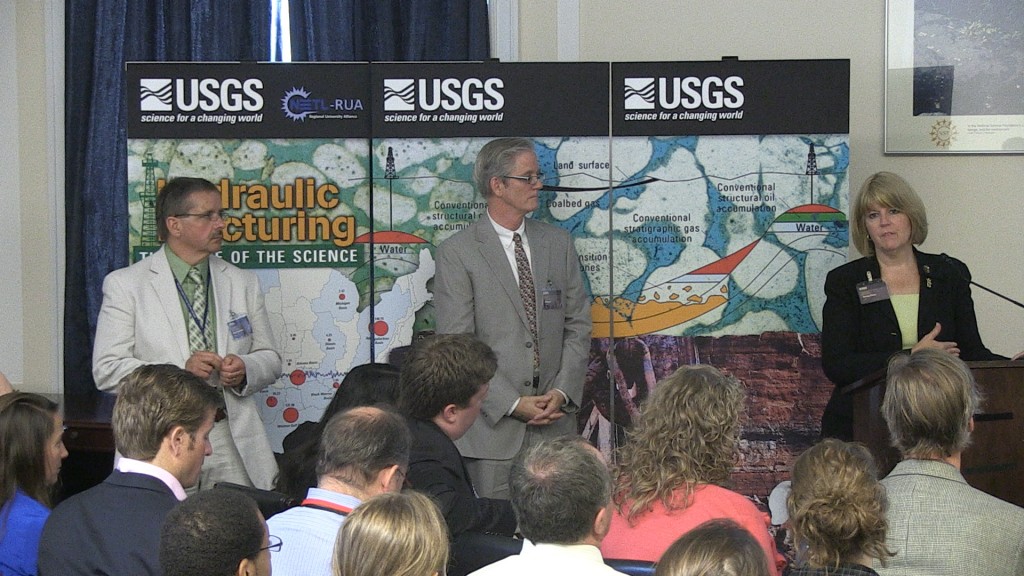28 June 2012
Fracking in the United States: Scientists’ research addresses multiple concerns
Posted by mcadams

Richard Hammack (left, DOE/NETL), Bill Leith (USGS) and Brenda Pierce (USGS) speak at a Congressional briefing, hosted by the USGS, about how they can help members of Congress make informed decisions on fracking. Credit: AGU.
From 2000 to 2010, improvements to a gas-drilling technology known as hydraulic fracturing have helped produce more domestic natural gas than in any other decade in U.S. history. While “fracking” has helped reduce natural gas prices and U.S. dependence on foreign supplies, the procedure is surrounded with contention concerning human and environmental health.
“There are adverse environmental changes that occur with hydraulic fracturing,” said Richard Hammack who is the Coordinator of Natural Systems Monitoring for the Department of Energy’s National Energy Technology Laboratory (NETL) – a collaborator of the U.S Geological Survey (USGS). “And part of our job is to find ways to mitigate those either through different management techniques or through development of new and better technology.”
Hammack was one of three speakers who discussed and presented their research at a Congressional briefing hosted by the USGS and co-hosted by the American Geophysical Union earlier this month.
To better understand how hydraulic fracturing affects various aspects of the environment, NETL has established a baseline monitoring site in southwest Pennsylvania where no fracking has yet occurred but will in the future. “We’re there very early so we can document the conditions that exist before any development takes place,” Hammack said. “And then we can monitor the changes to that baseline as shale gas development goes through its various stages.”
Hydraulic fracturing taps the vast reserves of natural gas confined in rocks deep beneath Earth’s surface. Fracking can also be used to extract more oil from underperforming wells. In order to extract natural gas and oil that is trapped within rock, such as shale, energy producers pump millions of gallons of water through a borehole that stretches thousands of meters below the surface. The water travels through steel pipes, parts of which are perforated allowing water to enter the rock. As increasing amounts of water enter the rock, pressure builds and eventually cracks, or fractures, the rock and releasing the trapped natural gas and oil inside. (See narrated animations — by major natural gas producer, Chesapeake Energy –for more detail.)
Specific environmental hazards that result from this process are still a subject of ongoing debate. Among them are earthquakes, but the quaking that results from fracking itself is rarely of any significance or safety concern compared to the earthquakes produced from disposing waste water from fracking, said the Senior Science Advisor for Earthquake and Geologic Hazards of the USGS, Bill Leith, another speaker at the June 8 briefing.
Companies dispose of fracking water, which is mixed with friction- and rust-reducing chemicals and therefore too contaminated to treat and recycle as drinking water, by pumping it into injection wells a few kilometers deep. Leith discussed how injections of fracking fluids along or near fault lines may trigger the faults to slip, resulting in an earthquake. “Below a few kilometers depth the Earth’s crust is everywhere stressed and we actually know that the stresses put the rock very close to failure,” he explained. “When the fluid pressure rises through injection into a fault, that [waste water] pushes the sides of the fault apart. That relieves the stress on the fault and allows it to slip due to a natural stress.”
In a recent study, Leith and his colleagues reported that the number of medium to large earthquakes – magnitude greater than 3 – in the United States was approximately 21 events per year in the 1970’s and increased to 151 events per year in 2008.
Mapping where the increases occurred, Leith said, showed that “This rate increase is associated with areas where there is production and disposal activities from these unconventional resource exploitations and production.”
Yet, only a moderate percentage of the approximately 40,000 injection wells in the United States have records of nearby earthquakes, Leith noted. There’s no concrete understanding as to why this percentage is not larger, he added.
The third panelist, Brenda Pierce, who is Coordinator of the Energy Resources Program at USGS, studies the quantity and degree of contamination of water used for fracking and the water’s disposal.
“We’re looking at produced waters associated with oil and gas development,” Pierce said. At the moment, Pierce and her colleagues are focusing on sites around the Bakken formation – an underground rock zone spanning parts of Montana, North Dakota, and Saskatchewan with vast reserves of oil now being extracted through fracking.
“In this area, we’re developing a methodology to quantify the amount of water use needed for these unconventional continuous type resources,” Pierce said. She and her colleagues are also looking into using alternative sources of water that have fewer chemicals and other contaminants.
Ultimately, Hammack, Leith, and Pierce said they hope their research will provide a body of knowledge that regulators and decision makers may use to make better, informed decisions on policy.
For more information, watch the entire briefing on YouTube, courtesy of AGU, here.
–Jessica Orwig, AGU Public Information Intern










 GeoSpace is a blog on Earth and space science, managed by AGU’s Public Information staff. The blog features posts by AGU writers and guest contributors on all sorts of relevant science topics, but with a focus on new research and geo and space sciences-related stories that are currently in the news.
GeoSpace is a blog on Earth and space science, managed by AGU’s Public Information staff. The blog features posts by AGU writers and guest contributors on all sorts of relevant science topics, but with a focus on new research and geo and space sciences-related stories that are currently in the news.